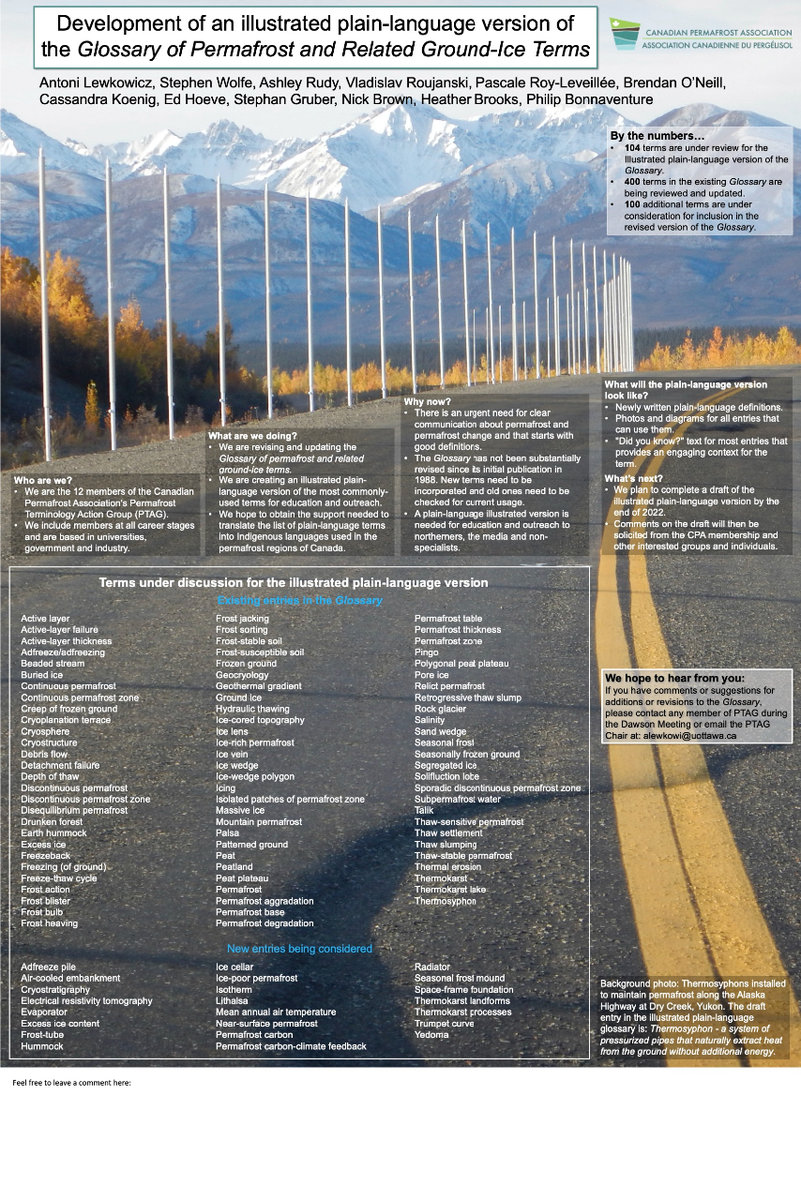The 12-member CPA Permafrost Terminology Action Group (PTAG) has been working for more than four years to revise the entries, definitions, comments and references in the IPA's 2005 version of the Multi-Language Glossary of Permafrost and Related Ground-Ice Terms. The new compilation will soon be published by the CPA as the Glossary of Permafrost Science and Engineering, the title change reflecting the extensive revision of the content. Of the 398 entries in the IPA's 2005 Glossary, 261 were modified to some degree, ranging from a few text edits to being entirely rewritten, 108 were eliminated, and only 29 remain unchanged. The 2025 edition will also include 64 new entries (e.g., air-cooled embankment, gas-emission crater, megaslump, permafrost carbon, space frame foundation), a number that reflects advances in knowledge within the field over the past two decades.
The audiences for the technical material in the Glossary of Permafrost Science and Engineering include researchers, practitioners and post-secondary students. In contrast, An Illustrated Permafrost Dictionary, which covers 100 of the most important terms, is primarily designed for non-experts. It was completed by PTAG and published by the CPA in 2024 and made available at the Whitehorse ICOP. The new Glossary will be released at the GeoManitoba 2025 conference in Winnipeg in September 2025, and will also become available for download from the CPA web-site.
Chair: Antoni Lewkowicz
There have been significant advances in permafrost science and permafrost engineering over the last 15-20 years and these should be reflected in the list of recommended terms and their definitions in the Multi-Language Glossary of Permafrost and Related Ground-Ice Terms. Furthermore, permafrost terms are now used by multiple communities (e.g., ecology, atmospheric modelling) and it is essential that revisions take these usages into account to improve the accuracy of communication. This will be especially important where conflicting, but established, usage exists (e.g., near-surface permafrost).
To systematically review and update the ~400 entries and definitions in the IPA’s Multi- language Glossary of Permafrost and Related Ground-Ice Terms compiled in 1998 and revised in 2005 by Robert van Everdingen. In addition, to verify that the terms conform to other controlled vocabularies and ontologies and to amend them where necessary.
The terms and definitions in the 2005 glossary were adopted, largely unchanged, from the Glossary of Permafrost and Related Ground-Ice Terms prepared in 1988 by the Permafrost Subcommittee, Associate Committee on Geotechnical Research of the National Research Council of Canada. An edited version of the 2005 edition (some terms are omitted) is available on-line and without translations as part of the Cryosphere Glossary at National Snow and Ice Data Center.
To develop plain-language descriptions and illustrations for the most commonly used terms. Audiences for these definitions include non-specialist scientists and engineers, decision-makers, the media, educators and the general public.
To organize the translation of the full Glossary into French and the plain-language descriptions into appropriate Indigenous languages.

Permafrost Terminology Action Group poster presented at the North Yukon Permafrost Conference in Dawson City, Yukon, 2022.